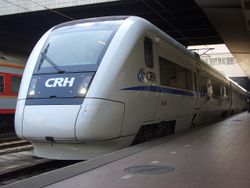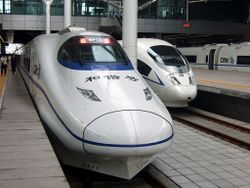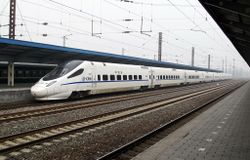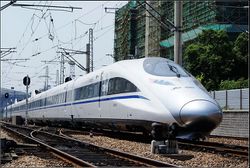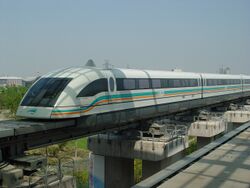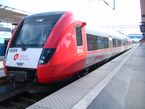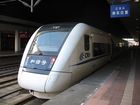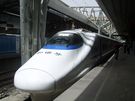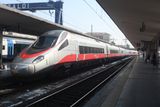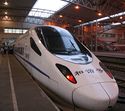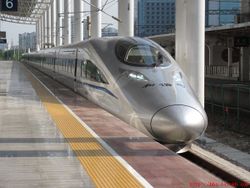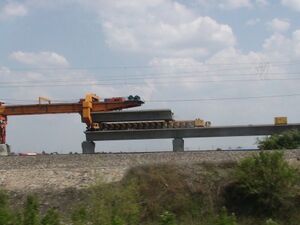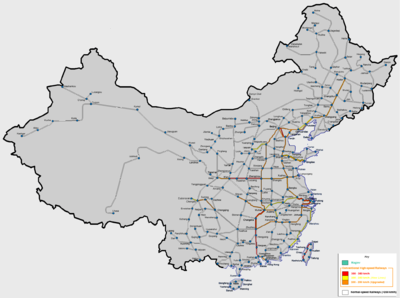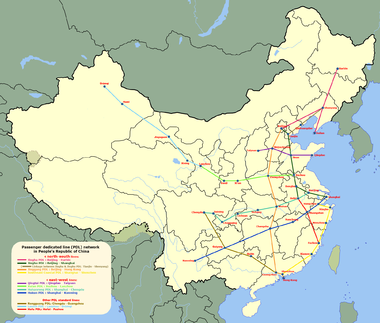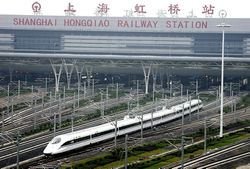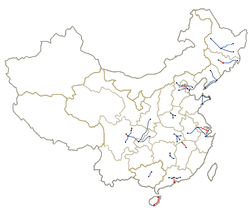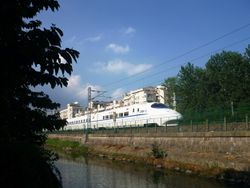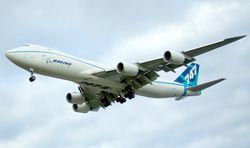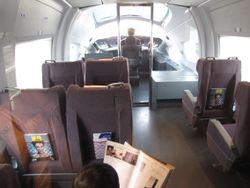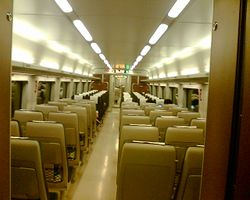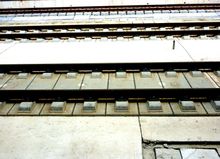السكك الحديدية عالية السرعة في الصين
السكك الحديدية عالية السرعة في الصين (الصينية المبسطة: 中国高速铁路; الصينية التقليدية: 中國高速鐵路; پنين: Zhōngguó gāosù tiělù؛ إنگليزية: High-speed rail in China) is the world's longest high speed railway network and most extensively used -- with a total length of 37,900 km by the end of 2020.[1][2][3] The HSR network encompasses newly built rail lines with a design speed of 200–350 km/h (120–220 mph).[4] China's HSR accounts for two-thirds of the world's total high-speed railway networks.[5][6] Almost all HSR trains, track and service are owned and operated by the China Railway Corporation under the brand China Railway High-speed (CRH).
High-speed rail developed rapidly in China over the past 15 years. CRH was introduced in April 2007 and the Beijing-Tianjin intercity rail, which opened in August 2008, was the first passenger dedicated HSR line. HSR extends to all provincial-level administrative divisions[N 1][N 2] except Macau[N 3]. The HSR network reached just under 38،000 km (24،000 mi) in total length by the end of 2020.[8] The HSR building boom continues with the HSR network set to reach 70،000 km (43،000 mi) in 2035.[9]
China's early high-speed trains were imported or built under technology transfer agreements with foreign train-makers including Alstom, Siemens, Bombardier and Kawasaki Heavy Industries. Since the initial technological support, Chinese engineers have re-designed internal train components and built indigenous trains manufactured by the state-owned CRRC Corporation.
The advent of high-speed rail in China has greatly reduced travel time and has transformed Chinese society and economy. A World Bank study found "a broad range of travelers of different income levels choose HSR for its comfort, convenience, safety and punctuality."[10]
Notable HSR lines in China include the Beijing–Guangzhou high-speed railway which at 2298 km is the world's longest HSR line in operation, and the Beijing–Shanghai high-speed railway with the world's fastest operating conventional train services. The Shanghai Maglev is the world's first high-speed commercial magnetic levitation ("maglev") line, whose trains run on non-conventional track and reach a top speed of 430 km/h (267 mph).[11] In 2020, China started testing a maglev prototype train that runs at 600 km/h and planned a 2025 launch date.[12]
التاريخ
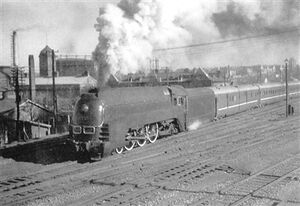
Precursor
The earliest example of higher-speed commercial train service in China was the Asia Express, a luxury passenger train that operated in Japanese-controlled Manchuria from 1934 to 1943.[13] The steam-powered train, which ran on the South Manchuria Railway from Dalian to Xinjing (Changchun), had a top commercial speed of 110 km/h (68 mph) and a test speed of 130 km/h (81 mph).[13] It was faster than the fastest trains in Japan at the time. After the founding of the People's Republic of China in 1949, this train model was renamed the SL-7 and was used by the Chinese Minister of Railways.
Early planning
حملات "زيادة السرعة"
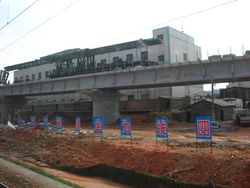
السكك الحديدية التقليدية وسكك حديد ماگلڤ
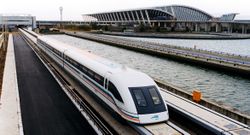
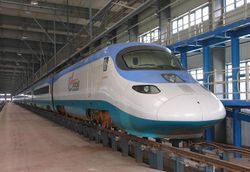
الحصول على التكنولوجيا الأجنبية
التوطين ورفع السرعة
تخفيض السرعة
التوسع الحالي
China's high-speed rail expansion is entirely managed, planned and financed by the Chinese government.
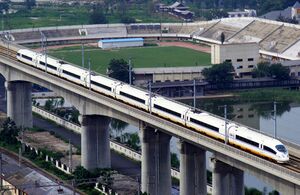
سياسة المبررات
تمويل انشاء السكك الحديدية عالية السرعة
China's high-speed rail construction projects are highly capital intensive. About 40–50% of financing is provided by the national government through lending by state owned banks and financial institutions, another 40% by the bonds issued by the Ministry of Railway (MOR) and the remaining 10–20% by provincial and local governments.[15][16] The MOR, through its financing arm, the China Rail Investment Corp (CRIC), issued an estimated ¥1 trillion (US$150 billion in 2010 dollars) in debt to finance HSR construction from 2006 to 2010,[17] including ¥310 billion in the first 10 months of 2010.[18] CRIC has also raised some capital through equity offerings; in the spring of 2010, CRIC sold a 4.5 percent stake in the Beijing–Shanghai high-speed railway to the Bank of China for ¥6.6 billion and a 4.537 percent stake to the public for ¥6 billion.[17] CRIC retained 56.2 percent ownership on that line. As of 2010, the CRIC-bonds are considered to be relatively safe investments because they are backed by assets (the railways) and implicitly by the government.
| Table:Construction cost of HSR lines in operation. | ||||||||||||||||||||||||||||||||||||||||||||||||||||||||||||||||||||||||||||||||||||||||||||||||||||||||||||||||||
|---|---|---|---|---|---|---|---|---|---|---|---|---|---|---|---|---|---|---|---|---|---|---|---|---|---|---|---|---|---|---|---|---|---|---|---|---|---|---|---|---|---|---|---|---|---|---|---|---|---|---|---|---|---|---|---|---|---|---|---|---|---|---|---|---|---|---|---|---|---|---|---|---|---|---|---|---|---|---|---|---|---|---|---|---|---|---|---|---|---|---|---|---|---|---|---|---|---|---|---|---|---|---|---|---|---|---|---|---|---|---|---|---|---|---|
|
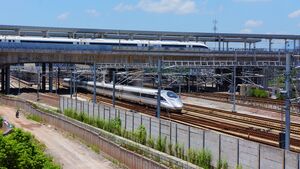
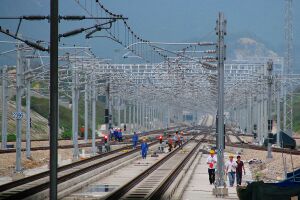
Large construction debt-loads require significant revenues from rider fares, subsidies, and/or other sources of income, such as advertising, to repay. Despite impressive ridership figures, virtually every completed line has incurred losses in its first years of operation. For example, the Beijing–Tianjin intercity railway in its two full years of operation, delivered over 41 million rides. The line cost ¥20.42 billion to build, and ¥1.8 billion per annum to operate, including ¥0.6 billion in interest payments on its ¥10 billion of loan obligations.[37] The terms of the loans range from 5–10 years at interest rates of 6.3 to 6.8 percent.[37] In its first year of operation from August 1, 2008, to July 31, 2009, the line carried 18.7 million riders and generated ¥1.1 billion in revenues, which resulted in a loss of ¥0.7 billion. In the second year, ridership rose to 22.3 million and revenues improved to ¥1.4 billion, which narrowed losses somewhat to below ¥0.5 billion.[37] To break even, the line must deliver 30 million rides annually.[37] To be able to repay principal, ridership would need to exceed 40 million.[37] In September 2010, daily ridership averaged 69,000 or an annual rate of 25.2 million.[37] In 2013, ridership totaled 25.85 million.[38] The line has a capacity of delivering 100 million rides annually[39] and initial estimated repayment period of 16 years.[37]
The Shijiazhuang-Taiyuan PDL lost ¥0.8 billion in its first year and is set to lose ¥0.9 billion in 2010.[17] The Southeast HSR corridor lost ¥0.377 billion in its first year beginning August 2009.[17] The Zhengzhou-Xian HSR since opening in February 2010 was expected to generate revenues of ¥0.6 billion in its first full year but must make interest payments of ¥1.1 billion. In the first three quarters of 2012, the line lost ¥1.87 billion.[40] The losses must be covered by the operator, which is usually subsidized by local governments.[39] In December 2014, the Henan provincial government imposed a rule requiring municipal authorities pay 70% of the deficit incurred by Henan's intercity lines with the provincial authorities paying the remainder 30%.[41]
The MOR faces a debt-repayment peak in 2014.[17] Some economists recommend further subsidies to lower fares and boost ridership and ultimately revenues.[39] Others warn that the financing side of the existing construction and operation model is unsustainable.[39] If the rail-backed loans cannot be fully repaid, they may be refinanced or the banks may seize ownership of the railways.[17] To prevent that eventuality, the MOR is trying to improve management of its rapidly growing HSR holdings.[17]
Overall, ridership is growing as the high-speed rail network continues to expand. High-speed rail is also becoming relatively more affordable as fares have remained stable while worker wages have grown sharply over the same period.[42] In 2016, the high-speed rail revenue was 140.9 billion RMB Yuan (20 billion USD), while the same term interest from at least 3300 billion debt of its construction was 156.8 billion RMB Yuan (22.4 billion USD).[43] According to the World Bank, a stable long term planning and standardization of technology and design used in the high-speed rail helps to reduce financial and operational cost. Standardization of designs and procedures such as train tracks, rolling stocks, signal systems keeps the construction cost down. Moreover, State-owned corporation also uses bulk purchasing to reduce material prices.[44]
Ticket cost comparisons
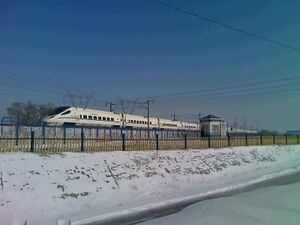
Currently, China's high-speed rail service costs significantly less than similar systems in other developed countries, but is considerably more expensive than conventional rail service.
| Trip | Distance | Price | Price US$/km | Time |
|---|---|---|---|---|
| HSR trip from Beijing to Jinan | 419 km (260 mi) | CNY185 (US$30) | 0.07 | 1 hour 22 minutes |
| HSR trip from Paris to Lyon | 428 km (266 mi) | CNY240 (US$39) | 0.1 | 2 hours |
| HSR trip from Madrid to Valencia, Spain | 391 km (243 mi) | €33–58 (US$41–72) | 0.11–0.18 | 1 hour 40 minutes |
| HSR train from Tokyo to Gifu-Hashima | 396 km (246 mi) | CNY270 (US$43) | 0.11 | 1 hour 56 minutes |
In comparison, high speed train tickets in France or Germany cost slightly over US$0.10 per kilometer and the various Shinkansen services hover above US$0.20 per kilometer.[45]
Impact on airlines
The spread of high-speed rail has forced domestic airlines in China to slash airfare and cancel regional flights.[46] The impact of high-speed rail on air travel is most acute for intercity trips under 500 km (310 mi).[46] By the spring of 2011, commercial airline service had been completely halted on previously popular routes such as Wuhan-Nanjing, Wuhan-Nanchang, Xi’an-Zhengzhou and Chengdu-Chongqing.[46] Flights on routes over 1،500 km (930 mi) are generally unaffected.[46] As of October 2013, high-speed rail was carrying twice as many passengers each month as the country's airlines.[42]
الشبكة
السكك الحديدية المحدثة
شبكة السكك الحديدية عالية السرعة الوطنية (4+4)
المسارات الأربعة من الشمال إلى الجنوب وخطوط التأسيسية
Operational lines are marked with green background.
| الخط [corridor map] |
وصف المسار | Designed Speed (كم/س) |
الطول (كم) |
تاريخ بدء الانشاء |
تاريخ الافتتاح |
|---|---|---|---|---|---|
| Beijing-Harbin PDL (Jingha Passenger Designated Line) |
main HSR corridor of Northeast China, consisting of the Beijing-Shenyang & Harbin-Dalian PDLs and the Panjin-Yinkou spur. | 350 | 1700 | 2007-08-23 | 2014 |
| Beijing-Shenyang PDL (Jingshen Passenger Designated Line) |
Beijing-Shenyang segment of Jingha PDL, via Chengde, Fuxin and Chaoyang | 350 | 684 | 2010 | 2014 |
| Harbin-Dalian PDL (Hada Passenger Designated Line) |
PDL from Harbin to Dalian via Shenyang & Changchun | 350 | 904 | 2007-08-23 | 2011-10 |
| Panjin-Yingkou PDL (Panying Passenger Designated Line) |
Connects Yingkou to Qinhuangdao-Shenyang HSR at Panjin | 350 | 89 | 2009-05-31 | 2012 |
| Beijing-Shanghai PDL (Jinghu Passenger Designated Line) |
Main north-south high speed railway of eastern China, connecting Beijing, Jinan, Tai'an, Xuzhou, Bengbu, Nanjing & Shanghai | 380 | 1302 | 2008-04-18 | 2011-06 |
| Hefei-Bengbu PDL (Hebeng Passenger Designated Line) |
Extends Jinghu PDL from Bengbu to Hefei | 350 | 131 | 2008-01-08 | 2012 |
| Beijing-Guangzhou PDL (Jinggang Passenger Designated Line) |
Main north-south high speed rail corridor through central China, consisting of four segments between Beijing, Shijiazhuang, Wuhan, Guangzhou, and Hong Kong. | 200- 350 |
2229 | 2005-09-01 | 2012 |
| Beijing-Shijiazhuang PDL (Jingshi Passenger Designated Line) |
HSR from Beijing to Shijiazhuang | 350 | 281 | 2008-10-08 | 2012-10-01 |
| Shijiazhuang-Wuhan PDL (Shiwu Passenger Designated Line) |
HSR from Shijiazhuang to Wuhan via Zhengzhou | 350 | 838 | 2008-10-15 | 2012-10-01 |
| Wuhan-Guangzhou PDL (Wuguang Passenger Designated Line) |
HSR from Wuhan to Guangzhou via Changsha | 350 | 968 | 2005-09-01 | 2009-12-26 |
| Southeast Coast HSR Corridor | High-speed railway linking coastal cities from Shanghai through Hangzhou to Shenzhen, built in five segments. With future additional link between Shanghai and Ningbo through a railway bridge across Hangzhou Bay before 2020 [47]. | 200- 350 |
1450 | 2005-08-01 | 2011 |
| Hangzhou-Ningbo PDL (Hangyong Passenger Designated Line) |
High-speed PDL from Hangzhou to Ningbo | 350 | 152 | 2009-04 | 2011-12 |
| Ningbo–Taizhou–Wenzhou Railway (Yongtaiwen Line) |
Mixed passenger & freight HSR line along the coast of Zhejiang Province. | 250 | 268 | 2005-10-27 | 2009-09-28 |
| Wenzhou–Fuzhou Railway (Wenfu Line) |
Mixed passenger & freight HSR line from Wenzhou to Fuzhou. | 250 | 298 | 2005-01-08 | 2009-09-28 |
| Fuzhou–Xiamen Railway (Fuxia Line) |
Mixed passenger & freight HSR line along the coast of Fujian Province from Fuzhou to Xiamen via Putian & Quanzhou. | 250 | 275 | 2005-10-01 | 2010-04-26 |
| Xiamen–Shenzhen Railway (Xiashen Line) |
Mixed passenger & freight HSR line along the coast of Fujian and Guangdong via Zhangzhou, Shantou & Huizhou. | 250 | 502 | 2007-11-23 | late 2012 |
المسارات الأربعة من الشرق إلى الغرب وخطوط التأسيسية
Operational lines are marked with green background.
| الخط [corridor map] |
وصف المسار | Designed Speed (كم/س) |
الطول (كم) |
تاريخ بدء الإنشاء |
تاريخ الافتتاح |
|---|---|---|---|---|---|
| Qingdao-Taiyuan PDL (Qingtai Passenger Designated Line) |
HSR across north China consisting of three segments connecting Taiyuan, Shijiazhuang, Jinan and Qingdao. | 250 | 873 | 2005-06-01 | 2012 |
| Qingdao-Jinan PDL (Jiaoji Line) |
PDL connecting Qingdao and Jinan | 250 | 364 | 2007-01-28 | 2008-12-20 |
| Shijiazhuang-Jinan PDL (Shiji Passenger Designated Line) |
PDL connecting Shijiazhuang & Jinan via Dezhou | 250 | 319 | 2009 | 2012 |
| Shijiazhuang-Taiyuan PDL (Shitai Passenger Designated Line) |
PDL connecting Shijiazhuang & Taiyuan. | 250 | 190 | 2005-06-11 | 2009-04-01 |
| Xuzhou-Lanzhou PDL (Xulan Passenger Designated Line) |
HSR across the Yellow River Valley of central China, consisting of four segments connecting Xuzhou, Zhengzhou, Xian, Baoji and Lanzhou. | 350 | 1363 | 2005-06-01 | - |
| Zhengzhou-Xuzhou PDL (Zhengxu Passenger Designated Line) |
PDL connecting Xuzhou & Zhengzhou | 350 | 357 | 2010 | 2013 |
| Zhengzhou-Xian PDL (Zhengxi Passenger Designated Line) |
PDL connecting Zhengzhou & Xian | 350 | 455 | 2005-09-01 | 2010-02-06 |
| Xian-Baoji PDL (Xibao Passenger Designated Line) |
PDL connecting Xian & Baoji | 350 | 148 | 2009-11-22 | 2012 |
| Baoji-Lanzhou PDL (Baolan Passenger Designated Line) |
PDL connecting Baoji & Lanzhou | 350 | 403 | planning | planning |
| Shanghai-Wuhan-Chengdu HSR Corridor (Huhanrong High-Speed Rail Corridor) |
HSR corridor through the Yangtze Valley, consisting of the Shanghai-Nanjing section of the Beijing-Shanghai PDL, and 7 mixed-use HSR segments connecting Nanjing, Hefei, Wuhan, Yichang, Lichuan, Chongqing, Suining & Chengdu. | 200- 350 |
2078 | 2003-12-01 | 2012 |
| Hefei-Nanjing HSR (Hening HSR) |
Mixed passenger & freight HSR connecting Nanjing & Hefei | 250 | 166 | 2005-06-11 | 2008-04-19 |
| Hefei-Wuhan Railway (Hewu Passenger Designated Line) |
Mixed passenger & freight HSR connecting Hefei & Wuhan | 250 | 351 | 2005-08-01 | 2009-04-01 |
| Hankou-Yichang Railway (Hanyi Line) |
Mixed passenger & freight HSR connecting Wuhan & Yichang | 250 | 293 | 2008-09-17 | 2012-01-01 |
| Yichang-Wanzhou Railway (Yiwan Railway, Yichang-Lichuan section) |
Mixed passenger & freight HSR connecting Yichang & Lichuan[48] | 200 | 377 | 2003-12-01 | 2010-12-23 |
| Chongqing-Lichuan Railway (Yuli Line) |
Mixed passenger & freight HSR connecting Lichuan & Chongqing | 200 | 264 | 2008-12-29 | 2012 |
| Suining-Chongqing Railway* (Suiyu Line) |
Mixed passenger & freight HSR connecting Chongqing & Suining | 200 | 132 | 2009-01-18 | 2012-01 |
| Dazhou-Chengdu Railway* (Dacheng Railway, Suining-Chengdu section) |
Mixed passenger & freight HSR connecting Suining & Chengdu. | 200 | 148 | 2005-05 | 2009-06-30 |
| Shanghai-Kunming PDL (Shanghai-Kunming Passenger Designated Line) |
PDL connecting eastern, central and southwestern China. It consists of three sections connecting Shanghai, Hangzhou, Changsha and Kunming. | 350 | 2066 | 2008-12-28 | 2014 |
| Shanghai-Hangzhou PDL (Huhang Passenger Designated Line) |
PDL connecting Shanghai Hongqiao & Hangzhou East. | 350 | 150 | 2009-02-26 | 2010-10-26 |
| Hangzhou-Changsha PDL (Hangchang Passenger Designated Line) |
PDL connecting Hangzhou & Changsha. | 350 | 926 | 2009-12-22 | 2013-06-30 |
| Changsha-Kunming PDL (Changkun Passenger Designated Line) |
PDL connecting Changsha & Kunming | 350 | 1175 | 2010-03-26 | 2013-06-30 |
خطوط أخرى
Operational lines are marked with green background.
| الخط [corridor map] |
وصف المسار | Designed Speed (كم/س) |
الطول (كم) |
تاريخ بدء<brالانشاء |
تاريخ الافتتاح |
|---|---|---|---|---|---|
| Guangzhou-Hong Kong PDL(Jinggang Passenger Designated Line) | Main HSR corridor on east side of the Pearl River Delta, consisting of two segments between Guangzhou and Hong Kong. | 200- 350 |
142 | 2008-08-20 | 2016 |
| Guangshengang XRL (Mainland Section) |
HSR from Guangzhou to Shenzhen | 350 | 116 | 2008-08-20 | 2011-07 |
| Guangshengang XRL (Hong Kong Section) |
HSR from Shenzhen to Hong Kong | 200 | 26 | 2010 | 2016 |
| Tianjin-Shenyang PDL (Jinshen Passenger Designated Line) |
Originally part of the Jingha PDL. An important linkage between Tianjin and Shenyang through Qinhuangdao. | 250 | 665 | 1999 | 2012 |
| Tianjin-Qinhuangdao PDL (Jinqin Passenger Designated Line) |
PDL connecting Tianjin & Qinhuangdao. | 350 | 261 | 2008 | 2012 |
| Qinhuangdao-Shenyang PDL (Qinshen Passenger Designated Line) |
PDL connecting Qinhuangdao & Shenyang. | 250 | 404 | 1999 | 2003-07-01 |
| Chengdu-Guangzhou PDL (Chengguang Passenger Designated Line) | HSR from the Pearl River Delta to the Sichuan Basin via Guiyang & Guilin. | 300-350 | 1376 | 2008-10-13 | 2014 |
| Chengdu-Guiyang PDL (Chenggui Passenger Designated Line) |
PDL connecting Chengdu & Guiyang via Leshan, Yibin & Bijie. | 350 | 519 | 2010 | 2014 |
| Guiyang-Guangzhou PDL (Guiguang Passenger Designated Line) |
PDL connecting Guiyang & Guangzhou. | 300 | 857 | 2008-10-13 | 2014 |
| Lanzhou-Xinjiang PDL (Lanxin Passenger Designated Line) |
HSR from Lanzhou to Ürümqi via Xining & Zhangye, Jiuquan, Jiayuguan, Hami & Turpan | 300 | 1776 | 2010 | 2014 |
| Hefei-Fuzhou PDL (Hefu Passenger Designated Line) |
HSR from the Hefei to Fuzhou via Huangshan, Shangrao & Wuyishan. | 250 | 806 | 2010-04-27 | 2014 |
| Datong-Xian PDL (Daxi Passenger Designated Line) |
HSR from Datong to Xi'an via Taiyuan. | 250 | 859 | 2009-12-03 | 2013 |
| Xian-Chengdu HSR (Xicheng High-Speed Railway) |
HSR from Xian to Chengdu via Hanzhong and Guangyuan. | 250 | 510 | 2010 | 2015 |
| Shangqiu-Hangzhou PDL (Shanghang Passenger Designated Line) |
HSR from Shangqiu to Hangzhou via Fuyang Hefei & Wuhu. | 350 | 770 | 2010? | - |
| Yunnan-Guangxi HSR (Yungui High-speed railway) |
HSR from Nanning to Kunming via Bose. | 200-250 | 710 | 2010-12-27 | 2016[49] |
| Tianjin-Baoding HSR (Jinbao High-speed railway) |
HSR from Tianjin to Baoding via Bazhou & Baiyangdian. | 250 | 158 | 2011-03-18 | 2013[50] |
| Nanjing-Hangzhou HSR (Ninghang High-speed railway) |
HSR from Nanjing to Hangzhou via Liyang, Yixing and Huzhou. | 350 | 249 | 2008-12-27 | 2011-12-31[51] |
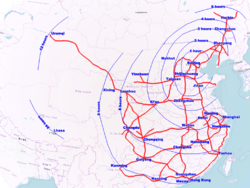
- Class I high speed railways
| الخطوط | الطول (كم) | السرعة (كم/س) | تاريخ بدء الانشاء | تاريخ الافتتاح | |
|---|---|---|---|---|---|
| Longyan-Xiamen | 171 | 200 | 2006-12-25 | 2011 | |
| Xiangtang (Nanchang)-Putian (Fuzhou) | 604 | 250 | 2007-11-23 | 2011 | |
| Nanping-Sanming-Longyan | 247 | 250 | 2010-12-25 | 2014 | [52] |
| Guangzhou-Nanning | 577 | 250 | 2008-09-11 | 2013 |
- تحت التخطيط
خطوط السكك الحديدية عالية السرعة بين المدن

Intercity railways are designed to provide regional high-speed rail service between large cities and metropolitan areas that are generally within the same province. Intercity HSR service speeds range from 200 to 350 km/h.
جدول الانشاء
Operational lines are marked with green background.
الخدمة
الركاب
عدد الركاب في السنة (بالمليون راكب) 2007 2008 2009 2010 ركاب خدمة القطارات عالية السرعة 61.21 127.73 179.58 290.54
خدمة القطارات عالية السرعة على الخطوط المطورة
خدمة القطارات عالية السرعة على الخطوط السريعة
التقنية
Rolling stock
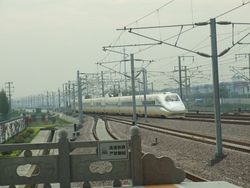
تقنية المسار
تصدير التكنولوجيا
خطوط ماگلڤ عالية السرعة
أرقام قياسية
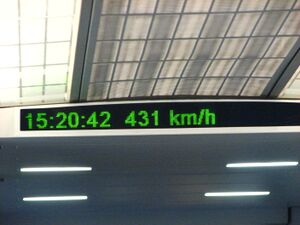
أسرع قطارات الصين
The "fastest" train commercial service can be defined alternatively by a train's top speed or average trip speed.
- The fastest commercial train service measured by peak operational speed is the Shanghai Maglev Train which can reach 431 km/h (268 mph). Due to the limited length of the Shanghai Maglev track (30 km)(18.6 mi), the maglev train's average trip speed is only 245.5 km/h (152.5 mph).
- The fastest commercial train service measured by average train speed is the CRH express service on the Beijing–Shanghai high-speed railway, which reaches a top speed of 350 km/h (220 mph) and completes the 1،302 km (809 mi) journey between Shanghai Hongqiao and Beijing South, with two stops, in 4 hours and 24 min for an average speed of 291.9 km/h (181.4 mph), the fastest train service measured by average trip speed in the world.[55][56][57]
- The fastest timetabled start-to-stop runs between a station pair in the world are trains G17/G39 on the Beijing–Shanghai high-speed railway averaging 317.7 km/h (197.4 mph) running non-stop between Beijing South to Nanjing South before continuing to other destinations.[58]
- The top speed attained by a non-maglev train in China is 487.3 km/h (302.8 mph) by a CRH380BL train on the Beijing–Shanghai high-speed railway during a testing run on January 10, 2011.[59]
Longest service distance
The G403/404, and G405/406 Beijing West (Beijingxi)-Kunming South (Kunmingnan) train (2760 km, about 12–13 hours), which began service on January 1, 2017, became the longest high-speed rail service in the world.[60] It overtook the G529/530 قالب:Station-قالب:Station (Beihai Railway Station) train (2697 km, 15 1/2 hours for southbound train, 15 3/4 hours for northbound train), which had set the previous record on July 1, 2016.[61]
قضايا السلامة والفساد
انتحار رئيس سكك حديد الصين
في 5 يناير 2014، انتحر "باي ژونگرن"، 53 عاماً، رئيس سكك حديد الصين، الذي جدد 10,000 كم من الشبكة لسرعة 350 كم/س في ست سنوات. سبب الانتحار: اكتئاب بسبب أجور العمال.[62]
انظر أيضا
ملاحظات
- ^ Taiwan High Speed Rail is not under the jurisdiction of China Railways (CR) nor is it connected with CR's network. However, official CR news reports now count Taiwan along with THSR in the figure.
- ^ Sichuan–Tibet railway is incorporated into the national high-speed rail service with the China Railway CR200J high-speed train.[7]
- ^ Zhuhai Station served by high-speed railways is close to Mainland-Macau border.
هوامش
- ^ "China's high-speed rail lines top 37,900 km at end of 2020". english.www.gov.cn. Retrieved 2021-01-15.
- ^ Ma, Yujia (马玉佳). "New high-speed trains on drawing board- China.org.cn". www.china.org.cn. Retrieved 2017-11-13.
- ^ chinanews. 2017年中国铁路投资8010亿元 投产新线3038公里-中新网. www.chinanews.com (in Chinese (China)). Retrieved 2018-01-13.
- ^ Lawrence, Martha; Bullock, Richard; Liu, Ziming (2019). China's High-Speed Rail Development. Washington, DC: The World Bank. p. 12. ISBN 978-1-4648-1425-9.
- ^ "Full speed ahead for China's high-speed rail network in 2019". South China Morning Post (in الإنجليزية). 2019-01-03. Retrieved 2019-06-23.
- ^ "China builds the world's longest high-speed rail as a rail stalls in the U.S." finance.yahoo.com (in الإنجليزية الأمريكية). Retrieved 2019-06-23.
- ^ "China-Tibet bullet trains to commence operations before July". Railway Technology. 8 March 2021.
- ^ "China's high-speed rail lines top 37,900 km at end of 2020 - Xinhua | English.news.cn". www.xinhuanet.com. Retrieved 2021-01-10.
- ^ Chen, Frank (August 24, 2020). "China sets railway building spree in high-speed motion". Asia Times.
- ^ Gerald Ollivier, Richard Bullock, Ying Jin and Nanyan Zhou, "High-Speed Railways in China: A Look at Traffic" World Bank China Transport Topics No. 11 December 2014, accessed 2017-07-17
- ^ "World's Longest Fast Train Line Opens in China". Associated Press. Archived from the original on 29 December 2012. Retrieved 26 December 2012.
- ^ "China to step up testing on fastest-ever maglev train". South China Morning Post (in الإنجليزية). 2020-08-11. Retrieved 2020-10-15.
- ^ أ ب Louise Young. Japan's Total Empire. Berkeley: University of California Press 1998. pp.246-7.
- ^ http://www.peoplerail.com/xinwen/20101027/n324636648.html
- ^ 铁路建设9成缺钱停工 多地高铁项目拖欠工人工资停工. 中国经营网 (in الصينية). 2011-10-26.
- ^ خطأ استشهاد: وسم
<ref>غير صحيح؛ لا نص تم توفيره للمراجع المسماةautogenerated5 - ^ أ ب ت ث ج ح خ 铁道部有意打包高铁资产 成立资产管理公司. 中财网 (in الصينية). 2010-09-25. Archived from the original on 2011-07-07. Retrieved 2010-10-02.
- ^ Shelley Smith "Yuan Bond Sales Climb to Record Led by Railways: China Credit" Bloomberg 2010-10-13
- ^ 我国首条快速客运专线"秦沈客运专线"开通. news.sina.com.cn (in الصينية). 2003-10-12.
- ^ 合宁铁路今天通车运营. ah.people.com.cn (in الصينية). 2008-04-18. Archived from the original on 2011-07-18.
- ^ 胶济铁路客运专线施工进入决战阶段 (in Chinese (China)). Archived from the original on 2011-07-26.
- ^ 石太铁路客运专线. China Railway (in Chinese (China)).
- ^ 合武铁路昨建成通车. Sina News (in Chinese (China)).
- ^ 甬台温铁路客运专线8月1日开通 (in Chinese (China)). Archived from the original on 2011-07-08.
- ^ 温福铁路温州段明天通货运 温州将迎来高铁时代. 温州网 (in Chinese (China)).
- ^ 福厦高铁正式开通运营 打造绿色环保"快车道" (in الصينية المبسطة). Archived from the original on 2011-07-20.
- ^ 成灌快铁开通四川迈入快铁时代. China Daily (in Chinese (China)).[dead link]
- ^ 昌九城际高铁今日开通 江西迈入高铁时代 (in Chinese (China)).
- ^ 东北首条城际高速铁路开通 总投资达96亿(组图) (in Chinese (China)). Archived from the original on 2011-01-14.
- ^ 东环铁今开通 本报今推《东环铁乘车指南》 (in Chinese (China)). Archived from the original on 2011-07-11.
- ^ 京津城际铁路通车新闻发布会 (in Chinese (China)).
- ^ 武广快线驶出中国新速度. China Daily (in Chinese (China)).
- ^ قالب:Cite work
- ^ 沪宁城际高铁通车 沪宁对开客运列车每日近百对 (in Chinese (China)).
- ^ 沪杭高铁简介及线路站点图示 (in Chinese (China)).
- ^ 京沪高铁开通首日上座率达98% (in الصينية المبسطة). Archived from the original on 2011-07-04.
- ^ أ ب ت ث ج ح خ 不计建设投资 京津高铁今年持平. 经济观察报 (in الصينية). Ifeng. 2010-09-18.
- ^ 京津城际高铁二线拟明年开工 或通过三河、香河、大厂. hexun.com (in الصينية). 2014-12-20.
- ^ أ ب ت ث 4万公里快速铁路网冲刺. 21世纪经济报道 (in الصينية). Ifeng. 2010-09-30.
- ^ 火爆城际铁路的上座率考验. 第一财经日报 (in الصينية). 2014-12-24. Archived from the original on 2014-12-27. Retrieved 2014-12-27.
- ^ 河南对城际铁路实行运营亏损补贴 补亏期暂定5年. 河南日报 [Henan Daily] (in الصينية). Ifeng. 2014-12-11.
- ^ أ ب Bradsher, Keith (2013-09-24). "Speedy Trains Transform China". New York Times. Retrieved 2013-09-26.
- ^ "谨防高铁灰犀牛". finance.sina.com.cn. January 28, 2019.
- ^ "China's Experience with High Speed Rail Offers Lessons for Other Countries". The World Bank. 8 July 2019.
- ^ "Is Low-Cost Intercity Rail Possible? | Pedestrian Observations". Pedestrianobservations.wordpress.com. Retrieved 2016-06-03.
- ^ أ ب ت ث 高铁分流民航客源:多条短程航班停飞. infzm.com (in الصينية). 2011-04-06. Archived from the original on 2013-10-29. Retrieved 2013-10-25.
- ^ "Railway Bridge to Cross Hangzhou Bay". HighBeam Business.
- ^ "Yiwan Railway: a project with 253 bridges and 159 tunnels". Xinhua. 2010-12-23. Retrieved 2010-12-23.
- ^ (Chinese) 云桂铁路开工建设 2010-12-27
- ^ (Chinese) 津保高铁预计2013年通车 从天津到保定1小时 2011-03-18
- ^ (Chinese) 年底南京到杭州坐高铁只需50分钟 2011-03-04
- ^ "南(平)三(明)龙(岩)高铁动工" 2010-12-26
- ^ "New intercity railway opens in NE China". China Daily. 30 December 2010. Retrieved 30 December 2010.
- ^ People's Daily, "Beijing-Zhangjiakou High-Speed Intercity Rail To Open In 2014", 25 January 2011.
- ^ 京沪高铁明提速 "复兴号"将在中途超车"和谐号". Caixin Companies (in Chinese (China)). Retrieved 2018-12-03.
- ^ "China restores bullet train speed to 350 km/h - Xinhua | English.news.cn". www.xinhuanet.com. Retrieved 2018-03-10.
- ^ "China begins to restore 350 kmh bullet train - Xinhua | English.news.cn". www.xinhuanet.com. Retrieved 2018-03-10.
- ^ "China powers ahead as new entrants clock in" (PDF). Railway Gazette International.
- ^ 中国北车刷新高铁运营试验世界纪录速度(图)-搜狐证券 (in Chinese (China)). Sohu Stocks. Archived from the original on 2011-07-20. Retrieved 2011-08-14.
- ^ "China launches longest high-speed train service" China Daily 2017-01-05
- ^ 北京西至北海将开通全国运行里程最长动车. 中国青年报 (in Chinese (China)). Sina News. 2016-06-15.
- ^ Sreeja VN (2014-01-06). "China Railway Group President Bai Zhongren's Death From An Unspecified Accident Might Be A Suicide: Local Media". IBTimes.
وصلات خارجية
- Ministry of Railways
- The International Maglev Board: Maglev in China
- www.tielu.org - Timetables and train connections (صينية)
- CS1 uses الصينية-language script (zh)
- CS1 Chinese (China)-language sources (zh-cn)
- CS1 الإنجليزية الأمريكية-language sources (en-us)
- CS1 الصينية-language sources (zh)
- CS1 الصينية المبسطة-language sources (zh-hans)
- Articles with dead external links from June 2016
- Short description matches Wikidata
- Articles containing simplified Chinese-language text
- Articles containing traditional Chinese-language text
- Articles containing إنگليزية-language text
- Pages using Lang-xx templates
- Articles with hatnote templates targeting a nonexistent page
- سكك حديدية عالية السرعة في الصين

